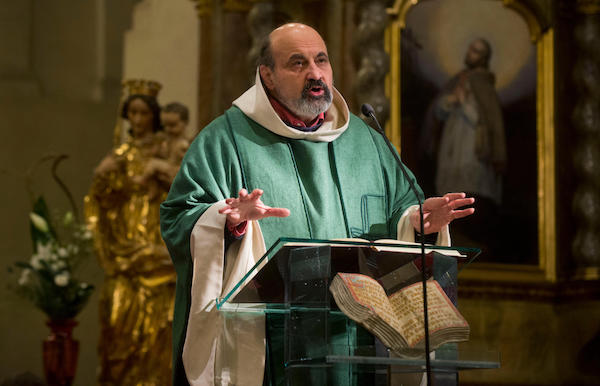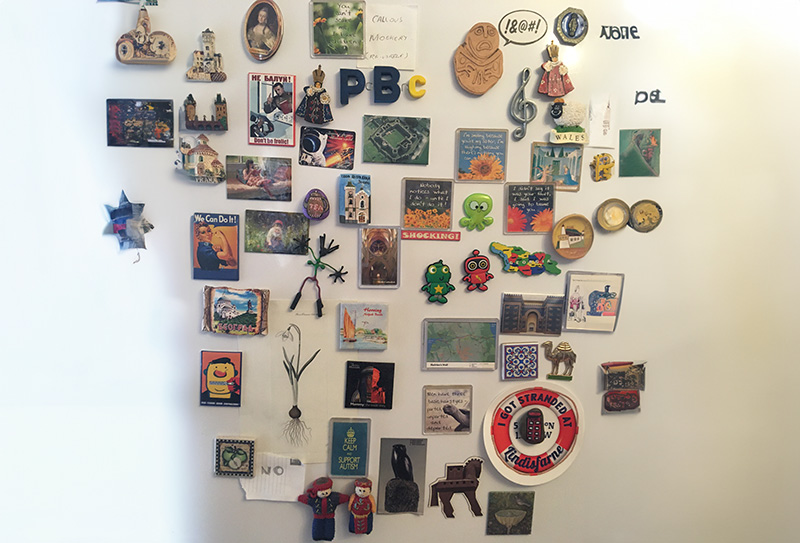I really need to do a cull of the fridge magnets, but I’m finding it very difficult. I can’t remember how the collection started. Where does the first fridge magnet come from? We had some originally that were simply magnets, no picture, no shape, and we used them to attach messages, memos and shopping lists to the fridge in lieu of a noticeboard, but now we have lots in all shapes and sizes. Originally they were used mainly to put up children’s pictures on the fridge.
I’m very impressed by people who put their children’s artwork into frames, but I think maybe they have fewer children than we do. And I do have some of the children’s artworks in frames. I tend to keep the more peculiar ones, because I like them best, so we have a batik tie-dye of the Lambton Worm, though I can’t remember which child made it, and Peter gave me a silk painting of lice (in tasteful shades of blue and green) following an art class at school where they were asked to paint one of the Plagues of Egypt. He thought lice sounded the most fun (there’s no accounting for taste), and then had a look on line to check what they looked like close up, so they are even anatomically correct. Edmund produced an artwork called ‘Security blanket’, made out of a grid of safety pins, and John made some rather scary ceramic heads. Rachel made a large animal halfway between a rhino and a hippo out of some material almost too heavy to lift. Things like that you can’t frame anyway. But the silk picture and the batik are in frames and on the wall; the fridge was the place for unframed paintings of the less permanent sort, and there needed to be magnets to keep them there.
We graduated to magnetic letters, both upper and lower case, because they were educational, though not all the messages were. And you need plenty of letters, because even a short message in English involves lots of ‘e’s. We also have a Cyrillic alphabet in fridge magnets, not quite so useful, because it has very few multiples and it takes longer to use (though there are devious games you can play: do you write a message in Russian or in English transliterated?). When I was grappling with Russian handwriting, we had a printed sheet of the alphabet held up by magnets, but it didn’t help as much as I had hoped. Later there were sets of magnetic words, which were trendy for a while, so we ended up with various sets and they were fun, but what started out as Romantic poetic diction quickly became Surrealist. The family blackboard is more useful for this sort of thing, because inspiration tends to get too far ahead of finding the words in the little box.
Now however, there’s no room for paintings because the fridge surface is almost entirely covered in magnets. A lot of them are geographical souvenirs of places we’ve been to, as almost everywhere now has a few for sale, and they are smaller and more portable than practically any other souvenir. My husband is particularly fond of the geographical ones, because you can use them at work (and no one else has as many). Some are more successful than others; I have a couple of miniature Turkish tile magnets, and they are beautiful little objects. Some are little independently-home-produced labours of love : we have a fretsaw-cut wooden silhouette of part of the Prague skyline, which I’m very fond of, but it’s fragile, so it has to stay at the top of the fridge for fear of it getting knocked off.
We have multiple Infant of Prague fridge magnets, because my mother had a special devotion to the Infant. When we were living there, I used to buy her a new one when the magnet maker painted a new outfit (in the same way that the keepers of the shrine dress the Infant in different outfits; he has a huge wardrobe, some canonically coloured, some simply opulent). But now I have inherited my mother’s, or some of them (I think there were enough for all the siblings to take some), as well as ours, and there are lots.
Those aren’t the only holy ones, either. Some of the picture reproductions are Madonnas, or angels, and one year when I was helping with the catechesis for First Confessions, we were all given a fridge magnet of the Rembrandt Prodigal Son. Holy fridge magnets present problems of disposal, like ancient Missals. It feels inappropriate to throw them away, however battered or faded they may be. My mother insisted that holy books or pictures could only be burnt, never discarded, but I don’t think burning a fridge magnet is a good idea.
The collection is so large because we had several fridges to park them on for a while, not just the home fridge, but the living-abroad fridge, and then the entertaining fridges once we were senior enough to need those. Things used to be a bit easier when we had a stand-up freezer, which gave us a second place to put them, but now we have a chest freezer, which is no help at all. Like the dishwasher and the boiler, its only usable surface is low and easy to brush against, so not good for line of sight, and too easy for magnets to disappear from. I may want to cull them, but I have my favourites, and I don’t want an indiscriminate cull. I once had a set of small wooden Moomintroll magnets from Helsinki, but alas, most are now lost, except for Snufkin (who is my favourite anyway). Our dishwasher has my set of planet fridge magnets swirling across its front, because there they aren’t being used to affix anything else, and Snufkin can be sent into various orbits and still be safe. But a set of planet fridge magnets takes up quite a bit of surface, and you can’t just throw out the planets you don’t like, it would unbalance the solar system. So far I haven’t lost any, which is lucky, because that would be an existential problem for the set.
Like so many things in the house, the fridge magnets are valuable to me because of what they represent; they are an astonishingly efficient way to remember a place, a time or a person. They are like nuggets of memory. Some represent a blissful afternoon exploring with the children (Beaumaris Castle, Hadrian’s wall, the Istanbul cistern). Some represent something significant, and yes, I do have a teapot magnet. It doesn’t look very much like a teapot, because it was handpainted onto a flat pebble by a Serbian friend for a bazaar in Belgrade, and she’d only ever seen coffee pots. But it has ‘TEA’ painted on it, because it was for a British charity event. (She also did telephone boxes, and I have one of those too.)
The various alphabet magnets I can dispose of in charity shops, and I can easily part with many of the jokey ones or those which are really advertisements. But that still leaves a great number. Some always make me smile. We have a reproduction of a Soviet propaganda war poster with a slogan and its helpful translation: ‘Don’t be frolic’, which is very appropriate for the whole family, and we have one of Rosie the Riveter, who my husband insists is a distant relative. I spent one meal being assured by his great-aunt that the Keefes had been murdered ‘to a man, I tell you’, in Ireland in the seventeenth century, so this seems unlikely, but after all, my husband exists, so I’m not arguing, and we’re keeping the magnet.
I have to keep the magnets which are like little avatars of the children when they are away (a pre-Raphaelite princess for Margaret, a toddler in a garden of flowers for Mary, a little robot for Edmund, a small octopus for John, a spaceman for Peter and a dragon for Rachel); but the geographical ones are hard to sort. Some I like just because they are so odd: we have a little gold camel with Chelyabinsk written on it, because it is the city’s coat of arms. It was chosen apparently because no other Russian city had a camel as its town badge; and afterwards, in order to justify it, the City Council put up a couple of camel statues in the main square. And it’s true, because I’ve seen them. We also have magnets for places it is no longer possible to access: one cherished, if garish, little model of a monastery in Abkhazia, which my husband once visited before the Russian annexation.
There are a lot of stories on my fridge, not just past family history, but wider than that. The only problem is there still isn’t enough space for them all. I may have to resort to the museum technique of mounting special exhibitions. Sometimes I arrange them to make a comic strip, but it’s time-consuming (I have a set of noise words (Zap! and Pow! for example, as well as British weather forecast symbols, so I can be quite creative). If the children were all still at home, I could share the load and nominate a curator for a week, but that’s not going to happen. I’ll have to keep some of them in a box, but I will try to get them out regularly, just to look at them and remember. Maybe I should try sneaking one or two on to the children’s fridges when I visit – but only if I know they will take care of them. Memories are precious.
Kate Keefe composes musical settings for the Mass and writes about the psalms. You can follow her on Facebook, Twitter and LinkedIn.



 Loading ...
Loading ...
What do you think?
You can post as a subscriber user ...
User comments (0)